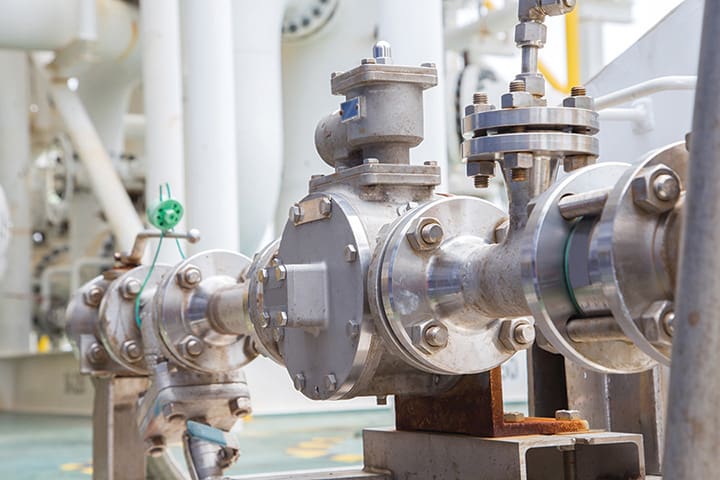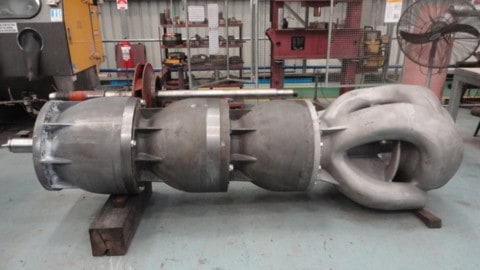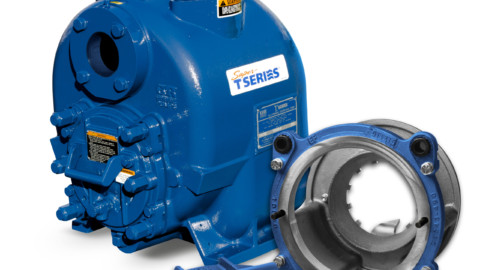The PIA’s Australian Pump Technical Handbook is a cornerstone text for the Australian pump industry and, in our opinion, a must have for anyone who deals with pumps on a regular basis. In this ongoing series, we feature abridged chapters from the classic book to showcase the various areas covered and to reacquaint readers with the technical aspects of pumps. In this issue, we explore the defining characteristics of positive displacement pumps.
Positive displacement pumps are pumps in which force is exerted upon movable boundaries of enclosed fluid containing volumes, causing a direct increase in pressure and resulting in the movement (or displacement) of the fluid.
Essentially, positive displacement pumps move fluids by transferring confined amounts of liquid from the inlet to the outlet of the pump.
Types of positive displacement pumps
There are two main types of positive displacement pump. These are:
- Reciprocating
- Rotary
- Reciprocating pumps
In reciprocating pumps, the pumping cavity is formed by one or more pistons, plungers or diaphragms reciprocating within a cylinder or pump barrel. Automatic valves control the flow in and out of the cavity.
Rotary pumps
In rotary pumps, the pumping cavity is generally formed by closely fitting elements that revolve continuously within a fixed casing.
The flow of fluid into and out of the pump is usually controlled by the rotary elements opening and closing the openings to the pump cavities, and there are no valves.
Flow versus speed
The amount of fluid displaced by a positive displacement pump changes in direct proportion to the running speed of the pump. These pumps are subject to internal leakage, which varies with factors such as pressure, viscosity of the fluid, pump speed, and condition of the pump. The pump output is reduced by the amount of internal leakage.
Therefore, at a constant operating speed, output flow from a positive displacement pump is essentially constant, almost vertical on a pressure versus flow curve.
Normally, positive displacement rotary pumps have greater internal leakage than their reciprocating counterparts and, as a result, the head discharge characteristic will depart more from the vertical for the same viscosity and pressure.
Effects of viscosity
As viscosity increases, internal leakage is reduced and friction power is increased in the system.
Internal leakage within positive displacement pumps can be quite high when pumping low viscosity fluids, especially at high pressures, but reduces to virtually zero at medium to high viscosities. However, friction power increases significantly with viscosity.
Consulting a pump supplier is recommended to calculate performance when pumping medium to high viscosity fluids.
Density – a non-issue
Density normally has no impact on the performance graphs or power calculations of positive displacement pumps. This is because it is accounted for in the conversion of static head to pressure.
Maximum pressure rating
Although positive displacement pumps have a “maximum” operating pressure, this is a nominal design figure selected to ensure a satisfactory lifespan without excessive wear or breakage.
The actual operating pressure is the pressure imposed on the pump discharge by the combination of static and dynamic (mainly pipe friction) head.
If a positive displacement pump is operated against a closed discharge valve, the pressure attained will only be limited by the driver, the strength of the materials composing the pump and piping, or, in some cases, by internal slip of liquid back to suction.
Unless overpressure protection is employed, only the breaking point of some component in the system will limit the pressure developed.
 Capacity control of positive displacement pumps
Capacity control of positive displacement pumps
In most cases, flow is regulated by varying the speed of pump operation.
Throttling is usually not recommended due to the danger of overpressure damage and power wastage. In some cases, a bypass from discharge back to suction can be used for flow control when speed control is not possible, but this also results in power being wasted.
A few types of positive displacement pumps have a built in ability to vary output (for instance, changing the pitch of screw pumps or varying the stroke length on plunger pumps).
Air-operated diaphragm pumps are automatically self-regulating in the sense that their rate of flow adapts to the delivery head as air pressure is varied.
Overpressure protection – relief valves
Overpressure protection is vital to all positive displacement pumps to protect against operating at a dead head, which will result in the breakage of the pump, pipe or another component of the system.
Many manufacturers offer pump-mounted relief valves to limit the maximum attainable pressure in the system. However, other options include system relief valves, rupture discs, torque-limiting couplings, pressure switches, and motor power load monitors.
Parallel and series operation of positive displacement pumps
When operating positive displacement pumps in parallel, each pump will deliver its rated flow against the pressure established by the system. Therefore, for normal volumetric efficiencies there will be no significant change in each pump’s output.
However, in cases of higher friction loss the system pressure will depend on the total capacity delivered.
Parallel operation should only be attempted after consultation with the pump manufacturer or supplier.
If the positive displacement pumps have high pulsation levels, pulsation dampeners may be necessary.
Pulsation can also pose a problem for series operation, as can flow variations between series pumps. These problems arise more frequently in systems with low slippage pumps or applications handling fluids of medium to high viscosities.
If positive displacement pumps are operated in a series, the first pump should be equipped with a pressure relief valve set to a pressure created by the first pump. In other words, the first pump should normally operate at an output greater than the delivery of the second pump for its differential pressure.
Further information and detailed diagrams, equations and schematics can be found in the Australian Pump Technical Handbook, available from the PIA website. In the next edition of Pump Industry, we go into further detail regarding selecting and applying different types of positive displacement pumps.

















